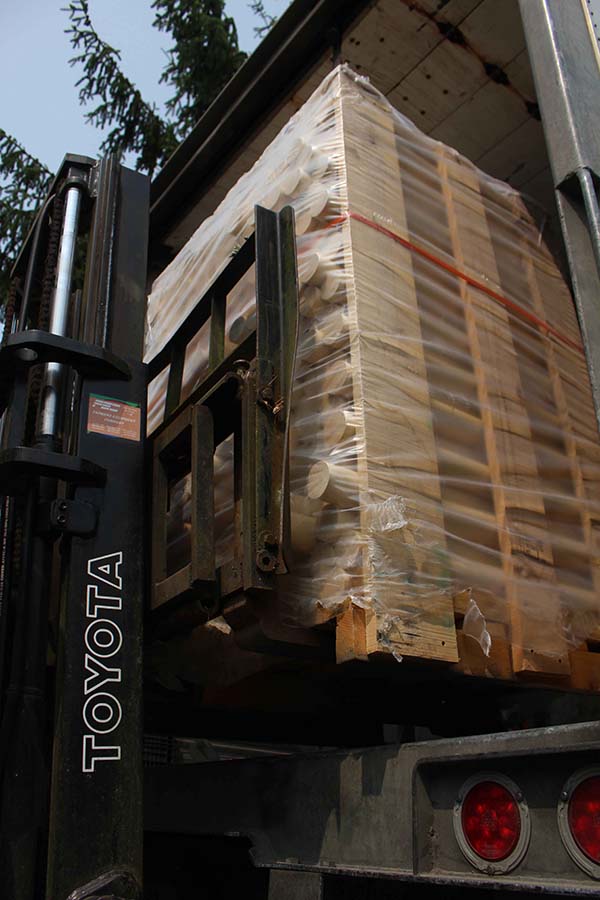Wood Bat Creation
Behind the Scenes
Here at Viper Bats we pride ourselves on the high quality of wood bats we turn out.
Now, we'd like to take you behind the scenes to see how they're made.
Harvesting and processing

The process for making a wooden bat can be pretty involved, but we would be remiss in not mentioning the most important part of the process, which starts working long before we do. To get the best bat possible, you need the right piece of wood.

We have multiple mills in the eastern halves of the United States and Canada supplying us with high quality ash, birch, maple and beech. The trees are harvested and shipped off to their mills where they are cut (shaped into rectangles), doweled (rounded out into cylinders) and dried (using a VAC/Kiln to reach their appropriate moisture content levels).
The drying process is especially important for its role in ensuring a hitting tool with the weight and density necessary to withstand a thousand at-bats, while providing the strength and firmness that gives our players that little extra "pop" that sends those balls on their way. After they have been dried, they are then sorted by straightness of their grain (the straighter the better), weight, visible blemishes, and graded accordingly. Then, they are sent to us.
Storage and preparation

Once we receive the skids of wood they are individually unloaded, weighed, inspected for grain straightness, and stored into our wood library. Our library is broken down by weight and species, organized accordingly and kept in conditions set to ensure maximum quality control from the time it reaches us to the time it reaches you.

Our detailed library is also the key to eliminating any mistakes, miscommunications or wasted time. When we receive an order, we get some very specific information, the most important being the model of the bat. Every model is unique in its weight distribution and in order to achieve the right weight in the final product, we need to know we're selecting the best billet for the job.
The Custom Crafting Processing Begins
Cutting
Once an order is received, a billet is selected, prepared and sent to the cutting floor.
Here, we insert the billet into a CNC lathe, which trims the billet to the exact specifications of the model requested with sharp, mechanical precision. When it comes out, though, it's easy to see that there's still something off-- or "on," in this case: to allow for the bats to be securely held in place by our machinery, we leave knobs protruding from each end.
For the most part, though, the shaping is done and is subsequently inspected for straightness of grain, weight and blemishes (such as knots, chatter marks and so forth). If any issues are detected that could even potentially result in a reduced-quality bat, the bat is marked as a "blem," set aside and we start over with a new billet. Once we've got a bat is deemed to be of high enough quality, however, it is sent off to our sanding station.
Sanding

The sanding station is where you can really start to see quality of our bats. Each bat undergoes no fewer than six cycles of vigorous sanding to ensure it comes out as smooth and comfortable as possible.
After the sixth cycle, the bat is "boned" to compress the grains and give it extra "pop" and durability. Then, it is sent through one final sanding cycle, deemed the "polish sand" to give at a nice shine.
Chopping
At the chopping area, the ends are removed and you can almost see the completed product. The only question, then, is whether the bat given bat will actually make it to a "completed" state. Up this point, it has been visually inspected several times over and if any issues have come up, we are well aware. But just because we've pegged some as "blems" doesn't necessarily mean we're necessarily going to throw them away or turn them into firewood.
Blems

While our highest quality bats are split up into a dozen or so different categories (our absolute best going into the Elite category), the blems get a chance at life on the field too.
They can't be customized or modified, but all of them, even those marked during the cutting process, get sent through the sanding process to ensure smoothness and safety and then are set aside for sale under "XX - Blemishes". They are sold at deep discounts with the explicit understanding that they are not expected to last as long or perform as well as our finished models.
Despite this, we have actually had more than a few customers compliment us on them, touting them as the ideal "practice bats" or "batting cage bats." And, even with the aforementioned understanding about quality, we stack on a small discount for those who want to buy our blems in bulk.
Finishing
Now, for those bats that manage to make the quality cut, what comes next is the "finishing" phase. Here, depending on the customer's specifications, the bat is labeled, optionally cupped to make it less end-heavy and and sent to the finish room. In the finish room, the bat is stained according the selections made way back when the customer first added the bat to their cart. (Despite all the benefits gained through our process up to this point, this has been deemed the "most exciting" part. Understandably. Between the handle, barrel and logo/text colors, there are over 1000 possible color combinations. A very small sample can be seen here.)
After the stain is set, the bat is sprayed with multiple clear coats which help seal in the color and bind the grains for greater hardness and durability. (Not to mention, it gives Viper bats that extra shine that makes them almost as beautiful as the distance you get off them. Sorry, /endShamelessPlug.) Once the bat has completely dried, it is trademarked, laser engraved with the customer's personalized text if requested (in which case it is followed up with another stain and spray) and then sent up to shipping.
Shipping

When the bat is finished, all that's left is for the brilliant, enlightened, web-savvy individuals up front to lovingly secure the bats in their snug, secure packages and whisk them on their away, accompanied by teams of wild stallions, white doves and a ceremonial parade.
Swing Hard, Hit Hard
This is our favorite part, where you get your bat, take it out into the world and bring the hurt. If you're holding one of our bats, no matter what team you're on, we're right behind you because you're also representing Team Viper. So, have at it: find your perfect bat.
Interested In Making Your Own?

For the hobbyist out there interested in making or just finishing their own bat, check out Woodbillets.com.
There, you will have access to wood billets for if you want to cut it from scratch, as well as pre-cut bats for if you just want to finish them yourself.